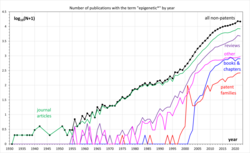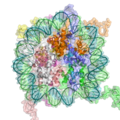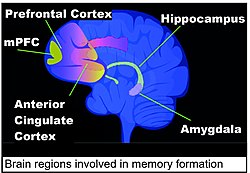Epigenetics
Epigenetics is the study of changes in gene activity which are not caused by changes in the DNA sequence.[1] It is the study of gene expression, the way genes bring about their phenotypic effects.[2] An organism's cells are, genetically, nearly identical. There are, however, certain occurrences that can change how genes are expressed or suppressed.[3]
These changes in gene activity may stay for the rest of the cell's life. They may last for many generations of cells, through cell divisions. However, there is no change in the underlying DNA sequence of the organism.[4] Instead, non-hereditary factors cause the organism's genes to behave (express themselves) differently. Epigenetics works by mechanisms such as DNA methylation, where a gene expression may be suppressed. [5][6]
Epigenetic factors may last into adulthood.[7]
Definitions
A general definition is "the study of... gene activity during the development of complex organisms".[8] Thus epigenetic can be used to describe anything other than DNA sequence which influences the development of an organism.
A stricter or narrower definition is "the study of mitotically and/or meiotically heritable changes in gene function which cannot be explained by changes in DNA sequence".[9] More simply, it is the study of cell division where there are changes in gene expression that cannot be explained by changes to the DNA of the cell.
The term "epigenetics" has been used to describe processes which are not heritable. An example is histone modification. So some definitions do not require heritability. Adrian Bird defined epigenetics as "the structural adaptation of chromosomal regions so as to register, signal or perpetuate altered activity states".[4] This definition includes DNA repair or cell division phases, and stable changes across cell generations. It excludes others such as prions unless they affect chromosome function.
The NIH Roadmap Epigenomics Project uses the definition: "...For purposes of this program, epigenetics refers to both heritable changes in gene activity and expression (in the progeny of cells or individuals), and also stable, long-term alterations in the transcriptional potential of a cell".[10]
In 2008, a consensus definition of the epigenetic trait, "stably heritable phenotype resulting from changes in a chromosome without alterations in the DNA sequence", was made at a Cold Spring Harbor meeting.[11]
A somewhat out of date but otherwise reliable and readable account is from The Guardian newspaper.[12]
Imprinting
Genomic imprinting in this context means tagging a gene for the lifetime of the individual. Tagging is the basic operation where cytosine amino acids have a methyl group added by the enzyme DNA methyltransferase. This changes the operation of that gene to be (usually) more favourable to the individual. Usually, it switches the gene off.[13]
In general, the advantage of this is to keep the gene output in the most favourable condition for the lifetime of the particular individual.[14]
Imprinting is giving rise to much medical research at present.[5]
Mammals
Imprinting seems to have evolved only about 150 million years ago in animals. It seems largely confined to mammals.[15][16] However, it may have originated separately (and earlier) in plants.[17]
Examples
The best example of epigenetic changes in eukaryotes is the process of cell differentiation, where a less specialized cell becomes more specialized. During morphogenesis, generalised stem cells become the cell lines of the embryo which in turn become fully differentiated cells. In other words, a single fertilized egg cell – the zygote – divides and changes into all the many cell types: neurons, muscle cells, epithelium, blood vessels etc.
As the embryo develops, some genes get switched on, while others are switched off or moderated.[18] This process is called gene regulation. There are many molecules inside the cell nucleus which do the job of adjusting the genes' output.
DNA and histones make up what is called chromatin. Epigenetic modifications to the chromatin are copied during cell division. This produces a line of cells, all of which are alike. This is called a tissue.
Meiosis cancels epigenetic changes, and resets the genome to its baseline state, so the process unfolds in each new generation. There are some exceptions to this rule, but none of these exceptions involve changes to DNA base pair sequences.
This process is different from mutations of the DNA. Genetic mutations change the primary DNA sequence, and mutations can happen in any cell. However, only mutations in cells involved in reproduction can affect the offspring.
Forms of genetic imprinting have been found in plants and filamentous fungi.[19][20]
Epigenetics Media
References
- ↑ By "DNA sequence" we mean the sequence of nucleotide base pairs in an exon, the part of a gene which makes the sequence of amino acids in the coded protein.
- ↑ King R.C. Stansfield W.D. & Mulligan P.K. 2006. A dictionary of genetics, 7th ed. Oxford. p146
- ↑ Moore, Lisa D.; Le, Thuc; Fan, Guoping (July 11, 2012). "DNA Methylation and Its Basic Function". Neuropsychopharmacology. 38 (1): 23–38. doi:10.1038/npp.2012.112. ISSN 1740-634X. PMC 3521964. PMID 22781841.
- ↑ 4.0 4.1 Bird A. 2007. Perceptions of epigenetics. Nature 447 (7143): 396–8. [1]
- ↑ 5.0 5.1 Carey, Nessa 2011. The epigenetics revolution: how modern biology is rewriting our understanding of genetics, disease and inheritance. London: Icon Books. ISBN 978-184831347-7
- ↑ Law, Julie A. & Jacobsen S.E. 2012. Establishing, maintaining and modifying DNA methylation patterns in plants and animals. Nature Reviews in Genetics 11 (3) 204–220. [2]
- ↑ Miller, Gregory E. et al 2015. (2015). "Self-control forecasts better psychosocial outcomes but faster epigenetic aging in low-SES youth". Proceedings of the National Academy of Sciences of the United States of America. 112 (33): 10325–10330. doi:10.1073/pnas.1505063112. PMC 4547243. PMID 26170291.
{{cite journal}}: CS1 maint: uses authors parameter (link) - ↑ Holliday R. (1990). "DNA methylation and epigenetic inheritance". Philosophical Transactions of the Royal Society of London. Series B, Biological Sciences. 326 (1235): 329–338. doi:10.1098/rstb.1990.0015. PMID 1968668.
{{cite journal}}: CS1 maint: uses authors parameter (link) - ↑ Riggs A.D; Russo V.E.A. & Martienssen R.A. (1996). Epigenetic mechanisms of gene regulation. Plainview, N.Y.: Cold Spring Harbor Laboratory Press. ISBN 0-87969-490-4.
{{cite book}}: CS1 maint: multiple names: authors list (link) - ↑ "Overview". NIH Roadmap Epigenomics Project. Archived from the original on 2019-11-21. Retrieved 2015-09-02.
- ↑ Berger S.L. et al. (2009). "An operational definition of epigenetics". Genes Dev. 23 (7): 781–3. doi:10.1101/gad.1787609. PMC 3959995. PMID 19339683.
{{cite journal}}: CS1 maint: uses authors parameter (link) - ↑ Rutherford, Adam 2015.Beware the pseudo gene genies The Guardian
- ↑ Plomin R. 2018. Blueprint: how DNA makes us who we are. London: Allan Lane (Penguin), p113. ISBN 978-0-241-36769-8
- ↑ Court F. and others 2014. Genome-wide parent-of-origin DNA methylation analysis reveals the intricacies of human imprinting and suggests a germline methylation-independent mechanism of establishment. Genome Research 24 (4): 554–69. PMID 24402520
- ↑ Lyon M.F. & Glenister P.H. 1977. Factors affecting the observed number of young resulting from adjacent-2 disjunction in mice carrying a translocation. Genetical Research 29 (1): 83–92. doi:10.1017/S0016672300017134. PMID 559611
- ↑ Butler 2009. Journal of assisted reproduction and genetics. 477–486.
- ↑ Fell, Robert & Berger Frédéric 2007. Convergent evolution of genomic imprinting in plants and mammals. Trends in Genetics. 23 (4): 192–9. [3]
- ↑ Reik, Wolf (2007). "Stability and flexibility of epigenetic gene regulation in mammalian development". Nature. 447 (7143): 425–432. doi:10.1038/nature05918. PMID 17522676. S2CID 11794102. Retrieved 2008-04-05.
- ↑ Martienssen RA, Colot V (2001). "DNA methylation and epigenetic inheritance in plants and filamentous fungi". Science. 293 (5532): 1070–4. doi:10.1126/science.293.5532.1070. PMID 11498574.
- ↑ Feil R. & Berger F. 2007. Convergent evolution of genomic imprinting in plants and mammals. Trends in Genetics. 23 (4): 192–9. [4]





